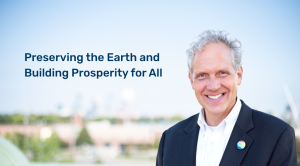
I chose to work at a nonprofit organization because it offered an entrepreneurial opportunity to address a pressing issue that I (and many around the world) care deeply about, which neither governments nor the private sector can fully address on their own: access for all to reliable, affordable, increasingly clean energy.
Most people don’t think much about energy unless their power goes out or the gas price goes up, but it correlates closely with a high quality of life and is among the most consequential human activities in terms of its impact on the environment upon which we all depend.
For me, that “big why” was top of mind last week as many marked the 55th Earth Day, when the world is simultaneously celebrating incredible advances in how we protect and preserve our planet and daunting new challenges to that same existential goal.
As with other big social movements, our progress has depended on the aspirations and decisions of millions of people.
As I reflect on the challenges and equally massive opportunities ahead for improving people’s lives and the rest of nature, I have found comfort and renewed inspiration in thinking about how GPI began as just a “mustard seed” of an organization.
What started with three people, now, nearly 30 years later and more than 80 people across the US, has become more like a deep-rooted prairie plant whose impacts have spread both locally and nationally, like prairie seeds on the wind.
Prosperity rooted in partnership
Today, across the United States, states and communities are working toward a clean energy future that is not only healthier and more sustainable but also more prosperous and inclusive. From small towns to big cities, we’ve seen firsthand that transformative progress doesn’t come from one-size-fits-all solutions. It comes from the ground up—from the roots—by building relationships, convening diverse stakeholders, and ensuring that all voices are heard.
That’s the heart of our approach at GPI: empowering coalitions, equipping communities and leaders at all levels with the information and tools they need, and elevating insights from people across all walks of life to deliver lasting economic and environmental benefits.
Building the table together
Whether we’re facilitating multi-state energy policy dialogues, helping rural communities access federal infrastructure funding, or advancing regional decarbonization strategies, the common thread in all our work is partnership and deep listening.
We don’t just bring people to the table—we build the table together. Our staff serve as honest brokers, helping stakeholders align on shared goals, understand complex technical issues, and move from dialogue to action. These coalitions include tribal nations, large and small businesses, labor unions, trade groups, environmental groups, utilities, farmers, state and local governments, and frontline communities.
While it’s not easy work, it’s essential. Because when we bring people together, especially those who don’t always agree, we unlock more durable, equitable, and pragmatic solutions. This “meet people where they are” approach offers an important antidote to today’s often fractured public discourse.
GPI’s track record of impact
We’re proud that GPI’s work has already helped deliver tangible benefits in hundreds of places. Some examples:
- In our home state of Minnesota, through the public-private GreenStep Cities program, we have helped hundreds of communities pursue their goals for resilience and economic and environmental sustainability.
- In the Midwest, facilitating the Midcontinent Power Sector Collaborative has helped shape one of the nation’s first regionally coordinated strategies to reduce power sector emissions while maintaining reliability and affordability.
- Working with partner organizations across the country and officials in most US states, we have helped states (some for the first time) develop comprehensive plans for boosting their economies, reducing energy costs and harmful emissions, and increasing their resilience in the face of increasingly severe and more frequent storms.
- By coordinating national coalitions like the Carbon Capture Coalition, we’ve helped secure bipartisan federal support for technologies that create jobs and support key industries while reducing emissions.
Behind every one of these successes is a commitment to deep listening, understanding what matters most to people on the ground, and building solutions that work for them.
Looking ahead
We are living through a time of profound change. The transition to a net-zero carbon economy is no longer a distant goal; it’s happening now both in this country and around the world. And while it can be slowed, it cannot be stopped because too many people from all walks of life want it.
This is not the first energy transition we humans have been through. Over the past 200 years, we have moved from wood to coal, then oil & gas and nuclear, and within the past 30 years, to renewable forms of energy (wind, solar, geothermal, etc.). These transitions have taken generations. This one must go faster.
As Earth Day 55 recedes in the rearview mirror, let’s make sure that this transition creates economic opportunities and environmental benefits for all. This means that communities being asked to host new energy facilities (which today could be literally anywhere) are engaged early and often and come to see these developments as something done with them and for them rather than to them.
We’ll continue to do our part by working together with partners and stakeholders to empower people with the tools, insights, and collaborative forums they need to shape their future, where economic vitality and a healthy environment become one and the same. I remain excited to see what we achieve together. I hope you’ll join us.
Interested in partnering with us or learning more about our work? Visit betterenergy.org or reach out—we’d love to hear from you.


